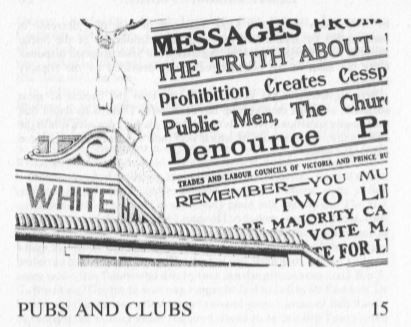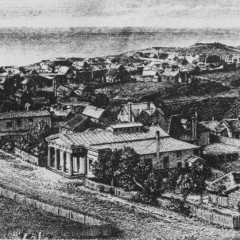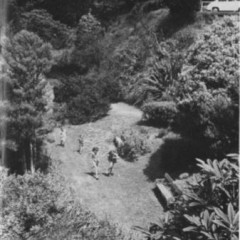15
Pioneering was thirsty work. A Liquor Licensing Ordinance was passed by central government in 1842, but for more than 40 years afterwards there was no effective restriction on the number of liquor outlets and virtually no control over the conditions in which liquor was sold. Less that 10 years after the arrival of the first settlers there were four breweries in New Plymouth which produced 'various sorts of ale, some of which was quite drinkable' I and by 1873 there were a least 13 licensed public houses and taverns- serving a population of less than 2000. (In 1980 the same number of hotels and taverns catered for acity population of almost 40,000.) During this period, and until the First World War, public drunkenness was common. In 1870convictions for drunkenness were 16.7 per 1000 of the country's population, and in 1910 it was 11.7%, compared with 2.0% in 1960. There is no reason to suppose that New Plymouth did not share in the grog trade, and the town suffered from no lack of enthusiasts who sought to curb the social and moral evils it produced. Extracts from the New Plymouth newspapers illustrate the feelings of a section of the community: 'Permit me to lay before your readers a brief account of the proceeding of the teetotal meeting held on Wednesday evening last. Of a truth, there was a goodly company-in fact, a regular crowd, an attendance far exceeding the most sanguine expectations of our committee.
Indeed, at this very early stage of their aggressive movement against the strong drinking system which has unhappily prevailed among us, the committee are not a little gratified in finding that their views upon total abstinence from all intoxicating liquors are becoming more popular. Hoping to trouble you at a future date.-One of the committee. The Police Department, maintained in an efficient state by the Central Government, has been reduced by the Superintendent to a Sergeant and two Privates, forcibly reminding one of the small but brave Army of Bombastes Furioso. It is notorious that a great proportion of the decrease in the Customs Revenue is attributable to private distillation carried on in New Plymouth; that kegs of spirits are daily sold to and retailed by the natives, and that the present reduced Police force is totally inadequate to check this evil, or to perform the duties required of it.' 5 On April 18, 1864, Colonel Warre, Officer Commanding Troops, wrote to the Magistrate's Court asking the authorities 'to refrain from issuing any more liquor licenses for another year at least.' He explained: 'I know that in a small community like this, when there is little attempt to tempt a man to commit Crime, that the principal offences are caused by Drink, and I know that in the Army nearly every serious Crime can be traced to Drink.'6 In 1873 'a return showing the number of convictions for sly-grogging in the Resident Magistrate's Court for the ten years 1863-73, with names of the persons convicted and the amount of the fine' 7 revealed there were 15 offences. The usual fine was $100 and in four cases imprisonment for four months in default of payment was imposed. One sly-grogger obviously found it worth the risk, for he was fined three times and imprisoned once. And 'G. H. M.' wrote to the editor of the Taranaki Herald, on April 7, 1908: 'Drunkenness increases in New Plymouth. Last year was a record year for drunks. Never in the last ten years were there so many charges before the court. There were 125 while the next highest was 105 in 1902, which you will remember was the last complete year of 11 o'clock closing. On the introduction of 10 o'clock closing there was a large drop in the number of charges; a fluctuating increase up to 1907, when, moderate drinkers of New Plymouth excelled themselves. I only wish to point out that increased drunkenness keeps pace with the increased consumption of alcohol-the two go together.' The campaign goes on. In common with the rest of the country-and the world-the drinking driver and his impact on the terrible road toll is the target of modern reformists. Drunk in charge of a horse or a bicycle were serious enough offences 100 years ago, even if, viewed in retrospect, they had an element of humor. Drunk in charge of a motor vehicle is another matter Of the four breweries in the town in 1850, the largest was owned by John Trigger, and beer was made in a raupo whare on the banks of the Mangaotuku Stream near Water Lane. By 1860, when New Plymouth had become little more than a military garrison, only one brewery was in existence. James Paul, who had previously joined the Otago gold rush, came to New Plymouth in 1862, and the following year opened a brewery which served the town and the country districts for almost 108 years until it ceased brewing in 1971. Paul became a prominent businessman, property owner and one of the leading figures behind the establishment of the Taranaki Harbour. He was two years Mayor of the town (1884-1886), a founder member of the Taranaki Jockey Club and New Plymouth Bowling Club, and was a member of the Amateur Opera Club and the Town Band. But it was for his association with the brewing trade that he is best remembered. In 1863, in partnership with W. Henderson, formerly of Wanganui, he opened the Egmont Brewery at the back of the Alexandra Hall on about the same spot now occupied by the stage of the Opera House. Business was good, and in 1877 he dissolved his partnership with Henderson and announced that he was building a larger brewery. The Taranaki Herald reported on October 22: 'Hitherto all New Plymouth buildings have been made of wood, but the great advantage of concrete will shortly be brought to the attention of the people of New Zealand. Mr Paul intends to erect his brewery in concrete at the back of his cottage in Queen Street'.
This 'new-fangled building material' came under fire from many quar- ters: 'Stone would be stronger', said one correspondent. But building proceeded and in 1878 the brewery was completed, new machinery was installed but 'there was no interruption to the supply of drink to the publis.:" There were many subsequent changes and additions to the brewery, but part of Paul' s original concrete building still stands, and has been described as 'the strongest bit of plain concerete work in Taranaki.' Water for brewing was obtained from a spring on the property, which was augmented in 1907 by a 200-foot bore. This became contaminated and in 1932 a switch was made to the borough supply. Wheat and barley was obtained from the nearby Union Flour Mill, and beer barrels were made by Joseph Ward's cooperage on the corner of Powderham and Brougham Streets. In the early years of this century the brewery grounds presented a park-like appearance, much frequented by visitors, courting couples and's pare- time drinkers. ' The staff was jealous of the appearance of the grounds and when a flight of tame ducks appeared they were resented. Appeals to the owner of the birds brought no response, so a sack of grain was left in a half-empty beer barrel and the next day it was strewn on the lawn. The ducks were easy to catch next day, and most of the staff had drunken duck for their Sunday dinner.
In 1897 Paul advertised that 'in order to meet the growing demands for non-alcoholic beverage for summer consumption' he had formed the Egmont aerated water factory, where he made Paula, 'a bracing tonic', Kola Champagne, and 'a fermented drink, Ginger Stout.' This was made by adding 'three gallons of Egmont Brewery Stout to 26 gallons of lemonade, and I confidently recommend it to persons to whom the real Mackoy is forbidden fruit.' Paul died in 1906, and the affairs of the company, which became the property of his widow, Alice, were managed by head brewers John Johnson and James Stevenson until 1927 when a new company, Taranaki Brewery and Cordials Ltd, was formed. The brewery ceased making cordials in 1959 and the name was changed to Taranaki Brewery Ltd. In November, 1968, the last annual report of the brewery reported authorised capital at $1 million and a net profit for the year of $192,201. The directors considered it 'a satisfactory year in view of the general restraint in credit and conditions which have affected trading in our particular area'. The following February a takeover offer by Dominion Breweries, Auckland, of 'two DB SOc shares for every three Taranaki Brewery shares' was accepted. A notice to shareholders said 'the separate local identity of Taranaki Brewery would be fully preserved' and 'the brewery will be maintained'.
In April, 1971, Dominion Breweries announced that brewing would be done at Auckland, 'to Taranaki Brewery specifications'. Beer would be brought in bulk to New Plymouth, and bottled under the name 'Taranaki'. (In 1970 Taranaki Brewery owned the Royal, Tasman, Imperial and White Hart hotels in New Plymouth and 12 others in various parts of the province). New Plymouth's early hotels were more thanjust drinking places and accommodation houses. In the first years of settlement they were often used as public meeting venues, and concert halls, and in one, at least, a temperance meeting was conducted. By the turn of the century more than 20 hotels had been established, some of which lasted only a few years; but several have retained their licences, though some names have changed, as have their appearances. In the 1960s large brewery firms bought several of the smaller hotels and established large motor hotels (with car parks to match) and taverns in the suburbs. The first hotel in New Plymouth-it was called a hostelry-was the Seven Stars Inn. It was established in a small raupo hut near the present Tasman Hotel in July, 1842, by John Wilkinson, and in November of that year the licence was transferred to 'William George the Younger', the deed being signed by Henry King, Resident Magistrate.
Less than eight years later the Seven Stars was demolished and rebuilt in 1853 on a site on the corner of Brougham and Devon Streets owned by F. A. Carrington. It was leased to various owners under the name of the Masonic and for many years served as concert hall, an accommodation centre, a public meeting place, a drinking parlour and a ballroom as well as a Masonic hall. After periods of depression, recovery and more depression, during which additions and alterations were made, competition from other hotels and the necessity for raising the building level with the newly elevated Devon Street proved uneconomic. In 1884 the large two-storeyed building, consisting of 13 bedrooms, a billiard room, several club rooms and a hall, was sold at auction by Carrington, for removal, to G. Corke, who bid $50 for the privilege. The buyer was the Bank of New Zealand. The Royal is the oldest existing hotel name in New Plymouth, although early records regarding its licence are meagre. Situated on the corner of Devon and Liardet Streets, the first Royal Hotel was built in 1852 and in 1865 the owner, Edward Cudlipp, sold it to William Cottier. Three years later the building was destroyed by a fire in which a young man, Peter Hillan, lost his life. Shortly afterwards Cudlipp erected a small building from what was left of the ruins, which went by the name of 'the Hole In The Wall'. It was opened without a licence and existed for little less than a year. 1 0 The present Royal Hotel on the corner of Brougham and Gill Streets began its career in the late 1840s as the Taranaki Inn. It had many landlords during the first half-century of its existence. One of them was William Cottier, who licensed it as Cottier's Taranaki Hotel in 1870. Four years later it was sold to Gottlieb Roch who renamed it the Taranaki Hotel, a name which it retained until early this century when it became the Royal. During its long career it has been the victim of several fires and, because of its proximity to the Huatoki Stream, floods. One flood in 1865, coupled with an exceptionally high tide, caused severe damage to the Royal and neighbouring buildings, and hundreds of rats sought refuge in rooms on a higher level in the hotel.


